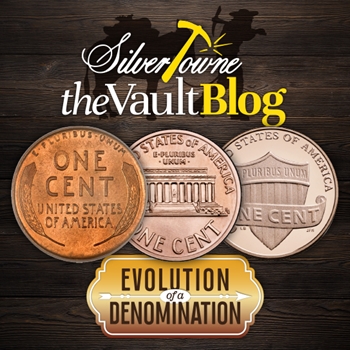
Since the small cent’s inception in 1856, its numerous design changes proved to display just how important not only a small cent coin was to the public, but a cent coin in general. From Flying Eagle cents to Indian Head cents, the coins endured a number of composition changes, design changes, and varieties. It was in 1909 that the decision to change the small cent design once again was made and it came just in time for the 100th anniversary of the birth of our nation’s 16th President of the United States, Abraham Lincoln.
Lincoln, Wheat Ears Reverse (1909-1958)
Based on precedence, officials avoided the depiction of presidents whether past or present on coins. However, the overhaul of United States coinage led by President Theodore Roosevelt led to the design for the new cent that would come to be from designer Victor David Brenner. Roosevelt and Brenner came to know each other from an encounter that had the president posing for the artist for a Panama Canal Service medal. Brenner has also already created a plaque and medal for the centennial of Lincoln’s birth. With a suggestion and possible design start, President Roosevelt agreed to let Brenner create and submit designs for the new small cent.
The obverse of the design featured Lincoln’s portrait facing right and the motto IN GOD WE TRUST. It would be the first time that a cent coin would read the inscribed words. Brenner’s initials (V.D.B.) would appear on the base of the reverse design on a limited number of coins dated 1909. Due to the public’s dislike of the initials, they were removed until they would be restored in 1918. Even though the initials were removed, 484,000 cent coins were minted with Brenner’s stamp on them from San Francisco which created a rarity in the series.
The Wheat Ears Reverse design was produced up until 1942 when the effects of World War II took over. Experiencing a copper shortage, the United States Treasury would utilize zinc-coated steel to make cent coins. The coins would be struck that way throughout 1943 with Philadelphia, Denver, and San Francisco producing the coin. While technically no bronze cent coins were issued in 1943, examples struck in error seemingly exist. Those examples are rare if they turn out to be real and have been known to sell for over $200,000. Bronze Lincoln Wheat cents would eventually resume production in 1944 and continue on until 1958.
Lincoln, Memorial Reverse (1959-2009)
On the 150th Anniversary of Lincoln’s birth and the 50th Anniversary of the Lincoln cent, a new Memorial reverse was introduced in 1959 depicting the Lincoln Memorial as designed by the assistant engraver of the United States Mint (future Chief Engraver), Frank Gasparro. Coins with this reverse were struck in copper alloy until 1982 when the composition would change to copper-plated zinc. This would continue until 2008.
Lincoln, Bicentennial (2009)
When the year 2009 rolled around, it was the bicentennial of President Abraham Lincoln’s birth and the 100th anniversary of the Lincoln cent. Due to such circumstances, the Mint decided to pay tribute to both as they would unveil four different designs on the reverse of the 2009-issued coin that would cover the unique life of Abraham Lincoln. The special reverse designs were released quarterly.
The first, Birth and Early Childhood in Kentucky, depicted a small log cabin like the one Lincoln was born in. The second, Formative Years in Indiana, features a young Abe taking a break from rail-splitting and reading a book. The third, Professional Life in Illinois, Lincoln is depicted standing in front of the Illinois state capitol building. The last coin, Presidency in Washington, shows a U.S. Capitol dome partially finished as it appeared to be when the President held office. The coins were released into circulation and were also struck in a special Proof finish.
Lincoln, Shield Reverse (2010-Date)
Once 2009 ended, a new reverse design took over in 2010 that continues on today. Designed by Lyndall Bass, the reverse features a shield to represent “President Lincoln’s preservation of the United States of America as a single and united country.” Philadelphia, Denver, San Francisco, and now West Point are featured mintmarks on the coins.
Source: NGC Coin; The Official 2021 Red Book







